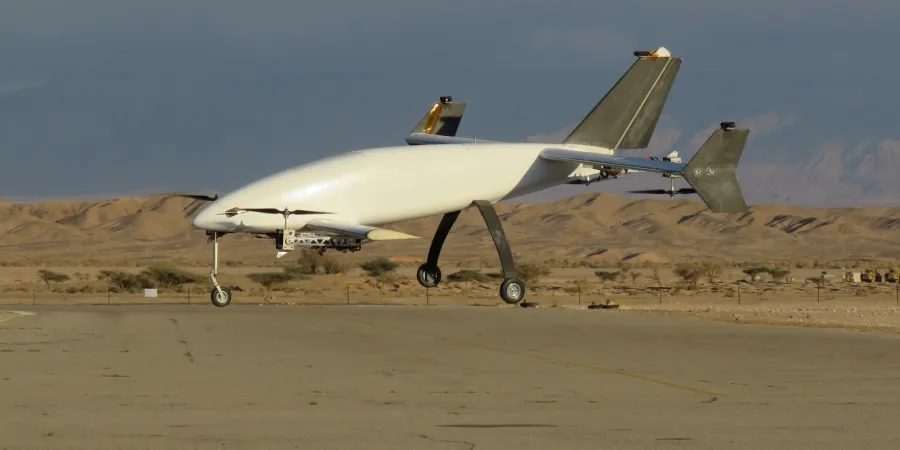APG Unveils New Family of VTOL UASs
The Peres UASs mark a significant breakthrough in technology, operation, and logistics as they can fly both horizontally and vertically, transitioning from vertical take-off to horizontal flight and from horizontal flight to vertical landing
IsraelDefense
| 19/03/2018
APG, an Israeli UAS designer and manufacturer, has unveiled the Peres family of UASs, delivering significant breakthroughs in technology, operation, and logistics. The Peres UAS can fly horizontally and vertically, transitioning from vertical take-off to horizontal flight and from horizontal flight to vertical landing.
Tactical UASs provide a solution for a variety of military missions, civilian applications, and commercial uses, such as ship-based take-off and landing, offshore drilling-rig access, ground-force logistical support, package delivery, and precision farming. The Peres can take off and land in a five-meter (16-foot) square area. It is among the first systems of its kind whose four engines enable it to transition from horizontal to vertical flight.
APG has successfully conducted final flight tests of the Peres 2 in preparation for aviation licensing and regulatory approval. The UAS has a wingspan of more than two meters (seven feet) and a maximum take-off weight (MTOW) of 93 lb. (42 kg). It has endurance of up to eight hours with a payload of 7.25 lb. (3.3 kg), a 93-mile (150 km) mission radius, and a cruising speed of 55 knots at an altitude of 8,000 feet with a service ceiling of 15,000 feet. To date, the company has developed, ground-tested and flight-tested the Peres 1 and Peres 2 UASs. APG's planned Peres 3 and Peres 4 will weigh more than 440 lb. (200 kg) and boast flight endurance of 12 hours.
"Most large UAV designers strive to provide travel and transport solutions to completely bypass road congestion and traffic jams in the future," says APG CEO Yair Dubester. "While many companies remain mired in the technological challenges of unmanned vehicles, APG is succeeding in removing roadblocks and implementing superior solutions that will be applied to airborne cars, trucks, and taxis. APG’s progressive UAS family supports standard flight functionality while delivering the quantum leap in engineering technology that enables UAS engines to transition to and from vertical and horizontal planes. Several drones are being developed with these capabilities, however they cannot support the weight, range, cruising altitude, and speed that the Peres affords. With the Peres, navies, drilling-rig operators, and military forces that need unmanned air power to support ground forces will be able to add the Peres’s trailblazing capabilities to their arsenals. APG’s technological successes are driven by the team’s experience and expertise in developing products that set the benchmark for the future in aerospace."
The Peres UASs mark a significant breakthrough in technology, operation, and logistics as they can fly both horizontally and vertically, transitioning from vertical take-off to horizontal flight and from horizontal flight to vertical landing
APG, an Israeli UAS designer and manufacturer, has unveiled the Peres family of UASs, delivering significant breakthroughs in technology, operation, and logistics. The Peres UAS can fly horizontally and vertically, transitioning from vertical take-off to horizontal flight and from horizontal flight to vertical landing.
Tactical UASs provide a solution for a variety of military missions, civilian applications, and commercial uses, such as ship-based take-off and landing, offshore drilling-rig access, ground-force logistical support, package delivery, and precision farming. The Peres can take off and land in a five-meter (16-foot) square area. It is among the first systems of its kind whose four engines enable it to transition from horizontal to vertical flight.
APG has successfully conducted final flight tests of the Peres 2 in preparation for aviation licensing and regulatory approval. The UAS has a wingspan of more than two meters (seven feet) and a maximum take-off weight (MTOW) of 93 lb. (42 kg). It has endurance of up to eight hours with a payload of 7.25 lb. (3.3 kg), a 93-mile (150 km) mission radius, and a cruising speed of 55 knots at an altitude of 8,000 feet with a service ceiling of 15,000 feet. To date, the company has developed, ground-tested and flight-tested the Peres 1 and Peres 2 UASs. APG's planned Peres 3 and Peres 4 will weigh more than 440 lb. (200 kg) and boast flight endurance of 12 hours.
"Most large UAV designers strive to provide travel and transport solutions to completely bypass road congestion and traffic jams in the future," says APG CEO Yair Dubester. "While many companies remain mired in the technological challenges of unmanned vehicles, APG is succeeding in removing roadblocks and implementing superior solutions that will be applied to airborne cars, trucks, and taxis. APG’s progressive UAS family supports standard flight functionality while delivering the quantum leap in engineering technology that enables UAS engines to transition to and from vertical and horizontal planes. Several drones are being developed with these capabilities, however they cannot support the weight, range, cruising altitude, and speed that the Peres affords. With the Peres, navies, drilling-rig operators, and military forces that need unmanned air power to support ground forces will be able to add the Peres’s trailblazing capabilities to their arsenals. APG’s technological successes are driven by the team’s experience and expertise in developing products that set the benchmark for the future in aerospace."



